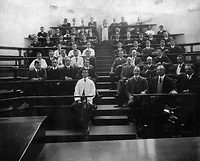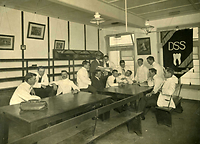


Developing dental education and research in Victoria
Introduction
Participants
Building a dental research culture
The influence of Frank Wilkinson
Developing linkages between the Dental School and Dental Hospital
The art and science of dentistry
The introduction and impact of fluoridation
Resolving a long-standing dispute with dental technicians
Training of dental health therapists
Dentistry's relationship with hospitals, government and industry
Controversy over the Dental School quota
The relationship between the School and the University of Melbourne
Relations between the School and the Australian Dental Association
The role of the School in childhood dental health
Funding research through the CRC and other programs
Personalities
Appendix; Some further thoughts stimulated by the Witness seminar
Endnotes
Index
Search
Help
Contact us

Ann Westmore: One of the areas we are exploring today is the development of a culture of research in the School. Can those who have been involved in the School over a long period recall to what extent research was a major undertaking.
Pat Storey: When Tony took over his Chair (in 1963), dental staff at the University published on average one research paper every thirty-three-and-a-third years. That was what it worked out as. So we spent many hours discussing the characteristics of a profession, and how dentistry might be lifted to become a profession.
We decided that research was an integral part of achieving that; it’s what lifted someone from a technician into a professional. So this was a very important area to concentrate on and develop.
Even before he got the Chair, when I first knew him, down in Spring Street, he was already involved in research. He was working in orthodontics and was interested in the movement of teeth. And one of the first things he got me to do was to plot the growth of my thumb nail through menstrual cycles to see if hormones made it grow more quickly.
John Harcourt: He also got me to do that, but not through menstrual cycles. (laughter)
John Hales: And what was the answer?
Pat Storey: Yes, there was a variation. So I think the first thing he did was to try to lead by example.
Henry Atkinson: Well, in defence of the Prosthetic Department. John [Harcourt] may know how many papers we published in the ten years before Tony came (1953-1963). That [low] figure [for research output] is correct if it is related to reviewed papers in pathological journals. I published in the Australian Dental Journal because it was local and to support the School and, at that time, it was the only journal read by members of staff and the profession. So it doesn’t take into account papers published elsewhere and the sudden burst that appeared in the Prosthetic Department.
John Harcourt: There was also work from ‘Tucky’[34] and Alan Docking[35].
Pat Storey: But they weren’t part of the School.
John Harcourt: Well, they were in a sense.
Henry Atkinson: Alan Docking didn’t do any work in the School and ‘Tuckie’ didn’t publish a single research paper under his own name.
Mike Morgan: They were part of the Dental Materials Research Laboratory, later known as the Commonwealth Bureau of Dental Standards.
Henry Atkinson: Tony was the first of the people in the Conservative Dentistry Department to do any active research. He worked in orthodontics. I remember the paper well where he reported a spurt of tooth movement during the menstrual period of schoolgirls.[36]


But much earlier, Frank Wilkinson[37] in 1924, started the University Research Committee which went on to 1934. And then Professor Amies changed the influence to pathology and he changed the name of Wilkinson’s Dental Research Laboratory to Pathology Museum, and research ceased. There was a great shortage of space in the School, and very little active work was done there. It was mainly done in the Departments of the University.
Ann Westmore: So was it mainly the shortage of space that was dictating that there wasn’t much research going on.
Henry Atkinson: It was two things. There was little or no research drive in the School at that stage, and lack of space was also an issue. So people worked in other Departments of the University, mainly in Biochemistry, Physiology or Pathology.
Ann Westmore: To what extent was there an interest in developing dental research throughout Australia and in overseas dental communities?
 |
Witness to the History of Australian Medicine |  |
© The University of Melbourne 2005-16
Published by eScholarship Research Centre, using the Web Academic Resource Publisher
http://witness.esrc.unimelb.edu.au/096.html